
Christmas 2020

Christmas 2020
 Fifty years ago this month my friend Ted Wise and I were privileged to spend a month in India. We traveled there by TWA Super Constellation from San Francisco, via New York, Paris, Frankfurt, and Rome to Bombay -- in an old fashioned 360 mph prop luxury airliner. See: Ted Wise and I visit India. Our trip changed us both forever! Ted's web pages are well worth a visit, especially his art gallery.
Fifty years ago this month my friend Ted Wise and I were privileged to spend a month in India. We traveled there by TWA Super Constellation from San Francisco, via New York, Paris, Frankfurt, and Rome to Bombay -- in an old fashioned 360 mph prop luxury airliner. See: Ted Wise and I visit India. Our trip changed us both forever! Ted's web pages are well worth a visit, especially his art gallery.
Arriving in the dead of night we took a taxi to our hotel through that very dark city. Real beds in a real hotel were very welcome. Later that Sunday morning we enjoyed a nice breakfast in our luxury hotel in Bombay (Mumbai). [Our hotel is in the photo at the left. The new hand-made hotel is the white building in the back. It was being built while we were there.]

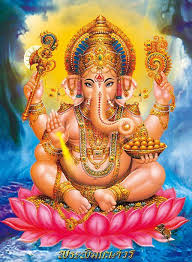 The omelets that morning were garnished with parsley and a tomato. I was ready to eat when a large green inch worm emerged from my tomato and marched triumphantly across my omelet and boldly over the white linen table cloth. The embarrassed waiter hastily brought me a new omelet with a worm-free tomato.
The omelets that morning were garnished with parsley and a tomato. I was ready to eat when a large green inch worm emerged from my tomato and marched triumphantly across my omelet and boldly over the white linen table cloth. The embarrassed waiter hastily brought me a new omelet with a worm-free tomato.
That week Ted and I saw zero evidence of holiday gift shopping, no Christmas trees, no Christmas cards in the mail. Ted and I were warm and comfortable in summer clothes in India as we explored the vast city over the next week. India Airlines was on strike, so after we spent several days seeing the city, we reluctantly boarded a "deluxe, air conditioned bus" for a 23 hour ride to Kerala, South India. We thought of our friends back in cold California gathering around the fireplace with mugs of hot buttered rum or spiced apple cider, The Time difference was +10 hours and home was 9000 miles away. Telephone service iffy.
We quickly realized that Christmas as we knew it is a cultural affair, with roots in Northern Europe centered on the Winter Solstice. I have since been in Egypt and Israel at Christmas season so it's clear to me that Christmas as we know it in the United States springs mostly from knowledge spread by the early church and by missionaries who brought the Bible to far distant lands. Yet there is a beautiful aspect of our western Christmas traditional and it's about giving and caring for others, not only our family members but the homeless, the sick, the unemployed. The God of the Bible is all about love, mercy, compassion and renewal.
India has a population today of 1400 million people. Christians number only about 2.3% of the population. Everyone in India is "religious." 80% of the people in India are Hindu, and 14% are Muslim! Underlying Hinduism is pantheism. Pantheism identifies the entire universe as God--the universe is a manifestation of God. Hinduism therefore admits or tolerates all gods. This is in contrast with theism, which maintains that god, or gods, are separate from the created order. The Bible portrays God as One being, not as many gods. Obviously the Western world is largely influenced by Deism. If a person in India claims to know Jesus, he may be risking his life.
Cultural Christianity in unknown there. Eastern religion was imported into our nation a half century ago largely through immigrants from China, Japan, India and the Far East. This was a big change, as the founding fathers were mostly Europeans and therefore mostly bringing with them theology handed down by the Reformed Church trailblazers.
In contrast, 80% of Europeans today say they are Christians, 4% say they are Muslim, 8% are "other" religion--few professing Christians in Europe know Jesus these days and are true believers. It's now well known that Christianity is fast fading away in Europe.
In Israel today only 2% are Christians, 40% are "secular," 14% are Muslims, and 40% are "religious" Jews. This will soon change as God has made many promises that He will restore the Jewish nation to her former glory after the calling out of a true church is complete. (See Romans 9-11).
The pie chart below for religious profession for the United States is revealing. If knowing Jesus Christ personally is what matters most, then the number of followers of Jesus Christ in the US is probably only 10-20%. There are obviously many Closeted or Compromised Christians in our country and others like them, hiding in the woodwork.
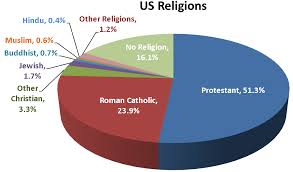
Europe and the rest of the world, except for monotheistic Israel--since Abraham (c2000 BC)--have been idolatrous nations. Christian values today tend to be only a thin veneer, skin-deep, in Europe and in the New World.
The Greeks, followed by the Romans "civilized" the world by reducing the main pantheon of the many pagan gods and spirits to a only a dozen or so. The Greeks invented 12 main (Olympian) gods, Zeus, Hera, Athena,Apollo, Poseidon, Ares, Artemis, Demeter, Aphrodite, Dionysos, Hermes, Hephaistos
The Romans adopted these, changing their names to: Jupiter, Juno, Mars, Mercury, Neptune, Venus, Apollo, Diana, Minerva, Ceres, Vulcan, and Vesta. The Greeks and Romans claimed they were civilized when they were not.
What is most important about Jesus is not His birth, which is highlighted at Christmas and heralded widely as the start of Advent season. Neither Jesus' brief thirty-year life nor his amazing teachings had much staying power then or now.
But for a man, who had been clearly dead, to return to life was what galvanized the early Christians. They took the Good News to the ends of the earth, beginning in Jerusalem. Often they did so at the cost of their lives. Their grand announcement is what we call today "the gospel."
“Moreover, brethren, I declare to you the gospel (Greek euaggelion) which I preached to you, which also you received and in which you stand, by which also you are saved, if you hold fast that word which I preached to you—unless you believed in vain. For I delivered to you first of all that which I also received: that Christ died for our sins according to the Scriptures and that He was buried, and that He rose again the third day according to the Scriptures, and that He was seen by Cephas, then by the twelve. After that He was seen by over five hundred brethren at once, of whom the greater part remain to the present, but some have fallen asleep. After that He was seen by James, then by all the apostles. Then last of all He was seen by me also, as by one born out of due time. For I am the least of the apostles, who am not worthy to be called an apostle, because I persecuted the church of God. But by the grace of God I am what I am, and His grace toward me was not in vain; but I labored more abundantly than they all, yet not I, but the grace of God which was with me. Therefore, whether it was I or they, so we preach and so you believed...” (1 Corinthians 15:1–11)
The message itself does not save, only the Man behind the message. "Nor is there salvation in any other, for there is no other name under heaven given among men by which we must be saved.” (Acts 4:12)
The Acts of the Apostles, written by a Greek Physician named Luke, launched a new activity of God in calling out a unique people from all nations--while God’s long term program for Israel was placed on hold.
The birth of a Savior in Bethlehem (probably in September 2 BC), is of course perennial good news for our weary world, but it was (and is) the raising of Jesus from the dead that changed history forever. The initial stir was at Pentecost, AD 30, 50 days after the resurrection of Jesus, that God began the calling-out (ekklesia) of a glorious church. That living Body is now nearly complete. The true church Jesus has been Himself growing for 2000 years stands in stark contrast to the visible groups and buildings which constitute a great counterfeit. But most of the world has no clue about the grand working of Jesus from creation to now. His death, burial, and resurrection changed history forever! See
Signs in the Stars? | Glimpses of Jesus | Growing up in Nazareth | His Final Trip to Jerusalem
Last Dinner with Friends in The Upper Room | Jesus, Plain and Simple
Then Peter, filled with the Holy Spirit, said to them, “Rulers of the people and elders of Israel: “If we this day are judged for a good deed done to a helpless man, by what means he has been made well, “let it be known to you all, and to all the people of Israel, that by the name of Jesus Christ of Nazareth, whom you crucified, whom God raised from the dead, by Him this man stands here before you whole. “This is the ‘stone which was rejected by you builders, which has become the chief cornerstone.’ “Nor is there salvation in any other, for there is no other name under heaven given among men by which we must be saved.” (Acts 4:8-12)
Then all the multitude kept silent and listened to Barnabas and Paul declaring how many miracles and wonders God had worked through them among the Gentiles. And after they had become silent, James answered, saying, “Men and brethren, listen to me: “Simon has declared how God at the first visited the Gentiles to take out of them a people for His name. “And with this the words of the prophets agree, just as it is written:
‘After this I will return
And will rebuild the tabernacle of David, which has fallen down;
I will rebuild its ruins,
And I will set it up; So that the rest of mankind may seek the LORD,
Even all the Gentiles who are called by My name,
Says the LORD who does all these things.’
“Known to God from eternity are all His works. (Acts 15:12-18)
Our cultural heritage in the West is derived more from the Greeks and Romans than from the Hindus and Muslims obviously. We even call it "Western Civilization" -- long held us as superior in every way to the values of "pagan" nations where the gospel had not yet gone. In the 19th and early 20th Centuries missionaries from the U.S. and Great Britain were dispatched from the West to plant churches, schools and hospitals in "Third World" countries. The sharp decline in Biblical piety in this nation has allowed full-scale invasion of the demonic. Our present overseas crusades and missions are but a shadow of the former glory.
When the Apostle Paul came to Athens in the First Century AD he spoke briefly but powerfully into that culture about the One, true God. What has changed today is our assimilation of alien gods and embracing of many pagan gods. Apart from a personal relationship with Jesus Christ, all men are lost!
| Now while Paul waited for them at Athens, his spirit was provoked within him when he saw that the city was given over to idols. Therefore he reasoned in the synagogue with the Jews and with the Gentile worshipers, and in the marketplace daily with those who happened to be there. Then certain Epicurean and Stoic philosophers encountered him. And some said, “What does this babbler want to say?” Others said, “He seems to be a proclaimer of foreign gods,” because he preached to them Jesus and the resurrection. And they took him and brought him to the Areopagus, saying, “May we know what this new doctrine is of which you speak? “For you are bringing some strange things to our ears. Therefore we want to know what these things mean.” For all the Athenians and the foreigners who were there spent their time in nothing else but either to tell or to hear some new thing. Then Paul stood in the midst of the Areopagus and said, “Men of Athens, I perceive that in all things you are very religious; “for as I was passing through and considering the objects of your worship, I even found an altar with this inscription: TO THE UNKNOWN GOD. Therefore, the One whom you worship without knowing, Him I proclaim to you: “God, who made the world and everything in it, since He is Lord of heaven and earth, does not dwell in temples made with hands. “Nor is He worshiped with men’s hands, as though He needed anything, since He gives to all life, breath, and all things. “And He has made from one blood every nation of men to dwell on all the face of the earth, and has determined their preappointed times and the boundaries of their dwellings, “so that they should seek the Lord, in the hope that they might grope for Him and find Him, though He is not far from each one of us; “for in Him we live and move and have our being, as also some of your own poets have said, ‘For we are also His offspring.’ “Therefore, since we are the offspring of God, we ought not to think that the Divine Nature is like gold or silver or stone, something shaped by art and man’s devising. “Truly, these times of ignorance God overlooked, but now commands all men everywhere to repent, “because He has appointed a day on which He will judge the world in righteousness by the Man whom He has ordained. He has given assurance of this to all by raising Him from the dead.” And when they heard of the resurrection of the dead, some mocked, while others said, “We will hear you again on this matter.” So Paul departed from among them. However, some men joined him and believed, among them Dionysius the Areopagite, a woman named Damaris, and others with them.“ (Acts 17:16-34) |
See Idolatry Notes.
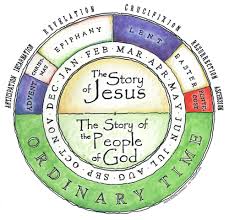 When exactly Jesus was born is secondary to the true spirit of Christmas. The fact is, many people ignore Jesus all their lives --except at Christmas--when sentimental memories encroach.
When exactly Jesus was born is secondary to the true spirit of Christmas. The fact is, many people ignore Jesus all their lives --except at Christmas--when sentimental memories encroach.
It's around Christmas when many read the gospel accounts of the birth of Jesus, the Star, the wise men from the East, the manger in Bethlehem, the wrath of King Herod in murdering all male babies in Bethlehem under two years old, the Flight to Egypt...
The Roman Catholic Church liturgical year starts in December with Advent. But the notion of a Liturgical year can be very misleading since God is not constrained by secular history nor by the proclamations a Pope or of any Caesar.
The giving of gifts at Christmas can be meaningful even at this late date in history. But an ominous giving-of-gifts will happen again when God's great witnesses are martyred outside the coming Third Temple in Jerusalem. Liturgical year Easter sometimes falls on or near the Jewish Passover. The Jewish calender is way better than our Roman calendars and the rituals of the Liturgical Calender when analyzing the life lived by the historical Jesus.
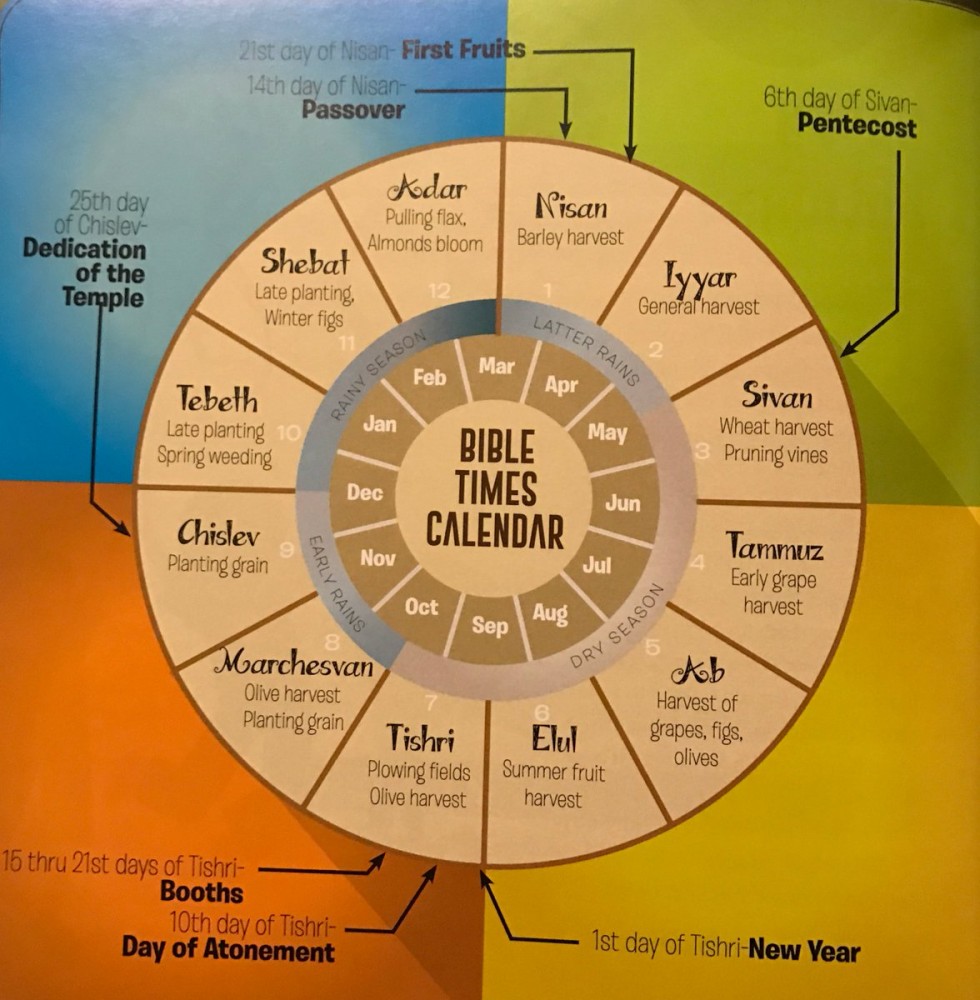
This yet future event is depicted in advance for us in Revelation Chapter 11:
Then I was given a reed like a measuring rod. And the angel stood, saying, “Rise and measure the temple of God, the altar, and those who worship there. “But leave out the court which is outside the temple, and do not measure it, for it has been given to the Gentiles. And they will tread the holy city underfoot for forty-two months. "
And I will give power to my two witnesses, and they will prophesy one thousand two hundred and sixty days, clothed in sackcloth.” These are the two olive trees and the two lampstands standing before the God of the earth. And if anyone wants to harm them, fire proceeds from their mouth and devours their enemies. And if anyone wants to harm them, he must be killed in this manner. These have power to shut heaven, so that no rain falls in the days of their prophecy; and they have power over waters to turn them to blood, and to strike the earth with all plagues, as often as they desire.
When they finish their testimony, the beast that ascends out of the bottomless pit will make war against them, overcome them, and kill them. And their dead bodies will lie in the street of the great city which spiritually is called Sodom and Egypt, where also our Lord was crucified. Then those from the peoples, tribes, tongues, and nations will see their dead bodies three-and-a-half days, and not allow their dead bodies to be put into graves.
And those who dwell on the earth will rejoice over them, make merry, and send gifts to one another, because these two prophets tormented those who dwell on the earth. Now after the three-and-a-half days the breath of life from God entered them, and they stood on their feet, and great fear fell on those who saw them. And they heard a loud voice from heaven saying to them, “Come up here.” And they ascended to heaven in a cloud, and their enemies saw them. In the same hour there was a great earthquake, and a tenth of the city fell. In the earthquake seven thousand people were killed, and the rest were afraid and gave glory to the God of heaven. (Revelation 11:1-11)

Time marches on! We're late in history now and a sovereign God is doing whatever He pleases down through history today as He always has done. This years Great Lockdown is not an accident. We can't fix the damage ourselves--life down here on the planet will never be the same! It's likely we are seeing a change of dispensations! The counterfeit church will soon have her day of greatest prominence in the form of one world religion. Just as the false church's historic focus has been mostly on the birth of Christ and not His current whereabouts and status, so she is now heralding the soon-coming of the Antichrist--the one who will be coming instead of the real Jesus! Having rejected the true, God will allow the world to be deceived by the counterfeit.
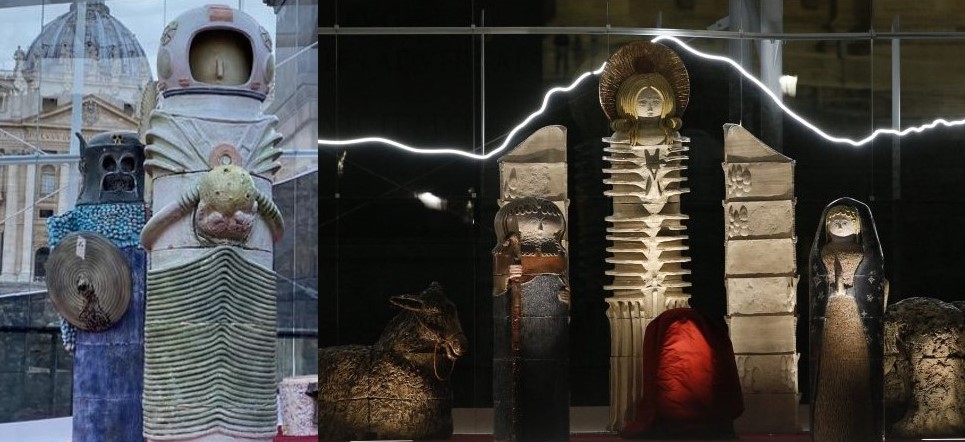
My friends Tom Horn and Derek Gilbert alerted us this week: "AT SKYWATCH TODAY we note that the Vatican is inaugurating a blatantly occult and bizarre Nativity Scene in Saint Peter’s Square combining “Ancient astronauts” (or “ancient aliens”) and occult Egyptian symbols that as part of the Christmas set.
What are they trying to communicate with this strange representation of the birth of our Lord?
Dr. Thomas Horn’s presentation warns that the Vatican is preparing to greet an “Alien Savior.” Is this spot on? Behind baby Jesus in the scene is a very odd version of the Archangel Gabriel clearly on top of a djed, one of the more ancient and commonly found symbols in ancient Egyptian religion of great importance in the rites of Freemasonry and their secret rituals pointing to arrival of Antichrist!
Please read: False Religion
The Emperor Constantine (306 to 337 AD), decided to make Christianity the one official religion of the Roman Empire. This was partly because many citizens in his empire had become followers of Jesus Christ. The pantheon of Roman gods was moved to the background.
In turn, the Christians brought the Biblical accounts of the birth of Jesus into Roman culture. This included suggesting that the birth of Jesus took place in winter, perhaps near the shortest day of the year, December 25. The official church of Rome then added teachings about the birth of Jesus that are not Biblically sound.
Thus Emperor Augustine in AD 202 had chosen December 25 as the official date of Jesus' birth. Emperor Aurelius identified December 25th as Sol Invictus in AD 354. St. Nicolas a very real Christian living in 4th Century Turkey became the legendary Santa Claus, and Christmas Tree legends were championed by Queen Victoria. The English term Christmas (“mass on Christ’s day”) is of fairly recent origin. The earlier term " Yule" may have derived from the Germanic jōl or the Anglo-Saxon geōl, which referred to the feast of the winter solstice. The corresponding terms in other languages—Navidad in Spanish, Natale in Italian, Noël in French—all probably denote nativity. The German word Weihnachtende notes “hallowed night.” Since the early 20th century, Christmas has also been a secular family holiday, observed by Christians and non-Christians alike, devoid of Christian elements, and marked by an increasingly elaborate exchange of gifts. In this secular Christmas celebration, a mythical figure named Santa Claus plays the pivotal role. Christmas is celebrated on Friday, December 25, 2020.
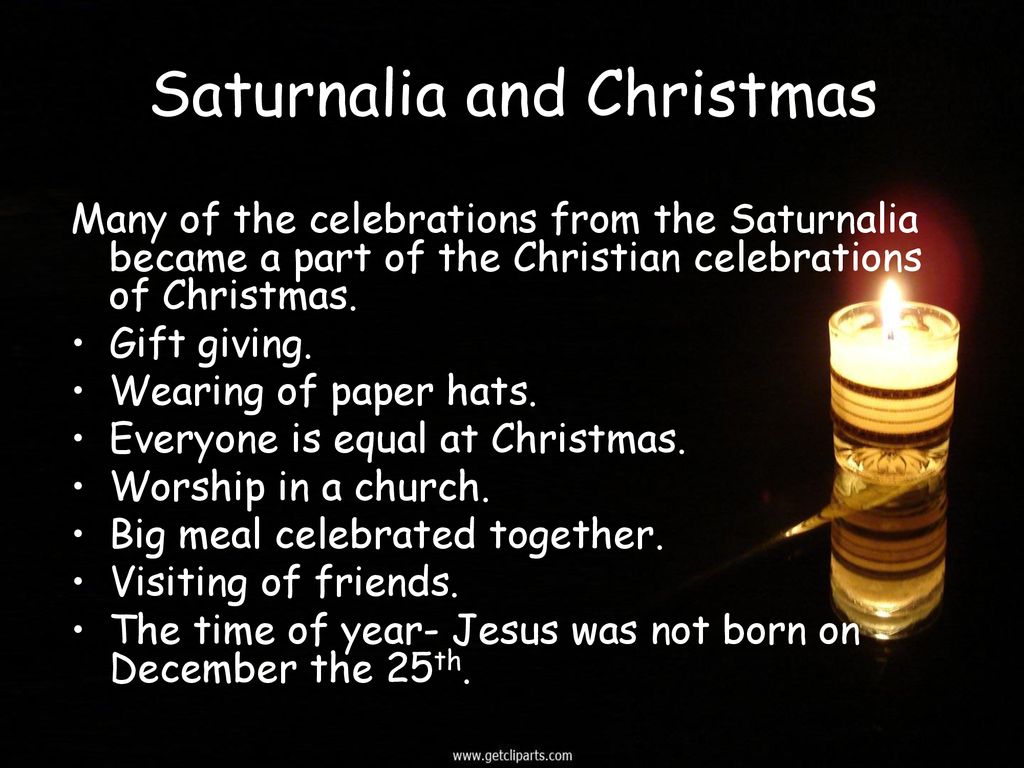
The precise origin of assigning December 25 as the birth date of Jesus is unclear. The New Testament provides no clues in this regard. December 25 was first identified as the date of Jesus’ birth by Sextus Julius Africanus in 221 and later became the universally accepted date. One widespread explanation of the origin of this date is that December 25 was the Christianizing of the dies solis invicti nati (“day of the birth of the unconquered sun”), a popular holiday in the Roman Empire that celebrated the winter solstice as a symbol of the resurgence of the sun, the casting away of winter and the heralding of the rebirth of spring and summer. Indeed, after December 25 had become widely accepted as the date of Jesus’ birth, Christian writers frequently made the connection between the rebirth of the sun and the birth of the Son. One of the difficulties with this view is that it suggests a nonchalant willingness on the part of the Christian church to appropriate a pagan festival when the early church was so intent on distinguishing itself categorically from pagan beliefs and practices.
A second view suggests that December 25 became the date of Jesus’ birth by a priori reasoning that identified the spring equinox as the date of the creation of the world and the fourth day of creation, when the light was created, as the day of Jesus’ conception (i.e., March 25). December 25, nine months later, then became the date of Jesus’ birth. For a long time the celebration of Jesus’ birth was observed in conjunction with his baptism, celebrated January 6.
Christmas began to be widely celebrated with a specific liturgy in the 9th century but did not attain the liturgical importance of either Good Friday or Easter, the other two major Christian holidays. Roman Catholic churches celebrate the first Christmas mass at midnight, and Protestant churches have increasingly held Christmas candlelight services late on the evening of December 24. A special service of “lessons and carols” intertwines Christmas carols with Scripture readings narrating salvation history from the Fall in the Garden of Eden to the coming of Christ. The service, inaugurated by E.W. Benson and adopted at the University of Cambridge, has become widely popular...
The tradition of celebrating Christmas as a secular family holiday is splendidly illustrated by a number of English “Christmas” carols such as “Here We Come A-Wassailing” or “Deck the Halls.” It can also be seen in the practice of sending Christmas cards, which began in England in the 19th century. Moreover, in countries such as Austria and Germany, the connection between the Christian festival and the family holiday is made by identifying the Christ Child as the giver of gifts to the family. In some European countries, St. Nicholas appears on his feast day (December 6) bringing modest gifts of candy and other gifts to children. In North America the pre-Christmas role of the Christian saint Nicholas was transformed, under the influence of the poem “A Visit from St. Nicholas” (or “ ’Twas the Night Before Christmas”), into the increasingly central role of Santa Claus as the source of Christmas gifts for the family. While both name and attire—a version of the traditional dress of bishop—of Santa Claus reveal his Christian roots, and his role of querying children about their past behaviour replicates that of St. Nicholas, he is seen as a secular figure. In Australia, where people attend open-air concerts of Christmas carols and have their Christmas dinner on the beach, Santa Claus wears red swimming trunks as well as a white beard.
In most European countries, gifts are exchanged on Christmas Eve, December 24, in keeping with the notion that the baby Jesus was born on the night of the 24th. The morning of December 25, however, has become the time for the exchange of gifts in North America. In 17th- and 18th-century Europe the modest exchange of gifts took place in the early hours of the 25th when the family returned home from the Christmas mass. When the evening of the 24th became the time for the exchange of gifts, the Christmas mass was set into the late afternoon of that day. In North America the centrality of the morning of the 25th of December as the time for the family to open presents has led, with the exception of Catholic and some Lutheran and Episcopal churches, to the virtual end of holding church services on that day, a striking illustration of the way societal customs influence liturgical practices. (Condensed from Wikipedia and Britannoca.com).
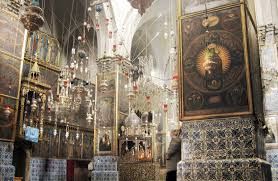 One sees imported Christmas traditions in Israel at Christmas season. For instance, in the ancient churches in Jerusalem. Israel today is a secular nation with a Christian minority of foreign origin and a small number of Messianic Jews. Israel today is a small country today-only 8500 square miles, about the size of New Jersey. The history of the land and the people is utterly amazing. God has put His stamp of ownership on Israel choosing her as a model for all nations to study and learn from. Now, late in world history Israel has risen from obscurity and is now center stage for the approaching consummation of history, well attested to by Old and New Testaments in the Bible.
One sees imported Christmas traditions in Israel at Christmas season. For instance, in the ancient churches in Jerusalem. Israel today is a secular nation with a Christian minority of foreign origin and a small number of Messianic Jews. Israel today is a small country today-only 8500 square miles, about the size of New Jersey. The history of the land and the people is utterly amazing. God has put His stamp of ownership on Israel choosing her as a model for all nations to study and learn from. Now, late in world history Israel has risen from obscurity and is now center stage for the approaching consummation of history, well attested to by Old and New Testaments in the Bible.
Travelers to Israel are not subjected to one point of view however. Cultural, racial, religious, political diversity abounds in the Holy Land. Israel today is populated by 8.855 million people. About 21% are Arabs, 75.6% are Jewish-70% of these are Sabras, (born in the land) and the rest Olim-Jewish immigrants, 21% from Europe and the Americas, 9% from Asia, Africa and Arab countries.
Only about 2% of the population of Israel is professing Christian. This number includes remnants from historical Christian churches dating from the First Century. “Messianic Jews” who acknowledge Yeshua are a vocal, but rapidly growing minority, in Israel numbering perhaps 1% of the populace. The religious segment of the Jewish population is about 8% Haredim (ultra-Orthodox), 25% “non-religious traditionalists” and 43% “secular.” (Wikipedia has much more for anyone interested).
Eastern Orthodox churches honour Christmas on December 25. However, for those that continue to use the Julian calendar for their liturgical observances, this date corresponds to January 7 on the Gregorian calendar. The churches of the Oriental Orthodox communion celebrate Christmas variously. For example, in Armenia, the first country to adopt Christianity as its official religion, the church uses its own calendar; the Armenian Apostolic Church honours January 6 as Christmas. In Ethiopia, where Christianity has had a home ever since the 4th century, the Ethiopian Orthodox Tewahedo Church celebrates Christmas on January 7. Most of the churches of the Syriac Orthodox Patriarchate of Antioch and All the East celebrate Christmas on December 25; at the Church of the Nativity in Bethlehem, however, the Syriac Orthodox celebrate Christmas on January 6 with the Armenian Apostolic Church. Congregations of the Coptic Orthodox Church of Alexandria follow the date of December 25 on the Julian calendar, which corresponds to Khiak 29 on the ancient Coptic calendar.
With the spread of Christianity beyond Europe and North America, the celebration of Christmas was transferred to societies throughout the non-Western world. In many of these countries, Christians are not the majority population, and, therefore, the religious holiday has not become a cultural holiday. Christmas customs in these societies thus often echo Western traditions because the people were exposed to Christianity as a religion and cultural artifact of the West.
In South and Central America, unique religious and secular traditions mark the Christmas celebration. In Mexico, on days leading up to Christmas, the search of Mary and Joseph for a place to stay is reenacted, and children try to break a piñata filled with toys and candy. Christmas is a great summer festival in Brazil, including picnics, fireworks, and other festivities as well as a solemn procession of priests to the church to celebrate midnight mass.
In some parts of India the evergreen Christmas tree is replaced by the mango tree or the bamboo tree, and houses are decorated with mango leaves and paper stars. Christmas largely remains a Christian holiday and is otherwise not widely observed.
Japan serves as illustration of a different sort. In that predominantly Shintō and Buddhist country, the secular aspects of the holiday—Christmas trees and decorations, even the singing of Christmas songs such as “Rudolph the Red-Nosed Reindeer” or “White Christmas”—are widely observed instead of the religious aspects. (Hans J. Hillerbrand, Britannica)
As noted, December 25 was the date of the winter solstice on the Roman calendar. A late fourth-century sermon by Saint Augustine explains why this was a fitting day to celebrate Christ's nativity: "Hence it is that He was born on the day which is the shortest in our earthly reckoning and from which subsequent days begin to increase in length. He, therefore, who bent low and lifted us up chose the shortest day, yet the one whence light begins to increase."Linking Jesus to the Sun was supported by various Biblical passages. Jesus was considered to be the "Sun of righteousness" prophesied by Malachi: "Unto you shall the sun of righteousness arise, and healing is in his wings."
Such solar symbolism could support more than one date of birth. An anonymous work known as De Pascha Computus (243) linked the idea that creation began at the spring equinox, on March 25, with the conception or birth (the word nascor can mean either) of Jesus on March 28, the day of the creation of the sun in the Genesis account. One translation reads: "O the splendid and divine providence of the Lord, that on that day, the very day, on which the sun was made, March 28, a Wednesday, Christ should be born. In the 17th century, Isaac Newton, who, coincidentally, was born on December 25, argued that the date of Christmas may have been selected to correspond with the solstice. According to Steven Hijmans of the University of Alberta, "It is cosmic symbolism ... which inspired the Church leadership in Rome to elect the southern solstice, December 25, as the birthday of Christ, and the northern solstice as that of John the Baptist, supplemented by the equinoxes as their respective dates of conception."
The Roman Empire itself has a long and interesting history and by no means is extinct today. A revived form of the Romans Empire will take place at the close of the age according to ancient predictions by the Prophet Daniel. Ray Stedman discusses this,
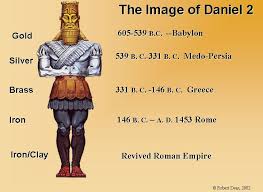 For three hundred years before Christ, the city-state of Rome, located on the banks of the Tiber River in Italy, had already dominated other city-states and tribes of Italy and had begun to thrust out into the Mediterranean world. Gradually its legions conquered territory throughout Italy and around southern France and into Spain, had crossed the seas into North Africa, was doing long-term battle with Carthage, and had begun to thrust out into Egypt, Greece, and east, almost to India. By our Lord's day, this kingdom was enthroned as the dominant power of earth. It is clear to us, as we look at history, that the Roman Empire was aptly symbolized by the iron of this image, because, as the prophet said, iron breaks to pieces and shatters and crushes. Anyone who has read the story of the Roman Empire knows how characteristic this was of Rome. They were dominated by a passion to rule the world and they had the power to achieve it and to continue that rule. Roman legions were known everywhere for their ability to fight, to march in and overwhelm all opposition, utilizing the short sword which became the famous mark of the Roman soldier. The Roman phalanxes and legions moved throughout the earth and eventually dominated every kingdom known to the Western world.
For three hundred years before Christ, the city-state of Rome, located on the banks of the Tiber River in Italy, had already dominated other city-states and tribes of Italy and had begun to thrust out into the Mediterranean world. Gradually its legions conquered territory throughout Italy and around southern France and into Spain, had crossed the seas into North Africa, was doing long-term battle with Carthage, and had begun to thrust out into Egypt, Greece, and east, almost to India. By our Lord's day, this kingdom was enthroned as the dominant power of earth. It is clear to us, as we look at history, that the Roman Empire was aptly symbolized by the iron of this image, because, as the prophet said, iron breaks to pieces and shatters and crushes. Anyone who has read the story of the Roman Empire knows how characteristic this was of Rome. They were dominated by a passion to rule the world and they had the power to achieve it and to continue that rule. Roman legions were known everywhere for their ability to fight, to march in and overwhelm all opposition, utilizing the short sword which became the famous mark of the Roman soldier. The Roman phalanxes and legions moved throughout the earth and eventually dominated every kingdom known to the Western world.
The chief mark of Rome was its resolute will to conquer. Will Durant, in his remarkable volumes, The History of Civilization, tells us that the Roman senate sometimes deliberately began wars in order to acquire further wealth for Rome or to quiet unrest among the plebeians and slaves at home. The Roman legions became synonymous with peace so that men boasted of what they called the Pax Romana, a peace of conquest by military might which kept everything stable and quiet throughout the Empire.
The third thing suggested by this prophecy is that Rome would stamp its image upon the entire Western world. Here is where we of the Western hemisphere enter the picture. The Roman government was marked by a passion to establish colonies and then to defend these colonies by military power. That characteristic of Rome has continued throughout the history of the West. Western nations have been colonizing nations who have reached to the uttermost parts of the earth. With the colonizing came the necessity for great military power to protect the trade routes and the colonies from being overwhelmed by others. Thus the Western nations became mighty militarily, protecting the colonies which they had established.
The Roman Empire was soon divided into two portions, corresponding to the two legs of iron of this image. One division was in the West, centered in Rome; the other was in the East, with Constantinople its capital, and became the Byzantine empire which colonized toward the north, into Russia, and into the east, to Persia, Iran and Iraq, and spread Byzantine culture all through the area.
In the West the empire centered on Rome. It first mastered the whole of the Mediterranean area and Western Europe and even after the fall of Rome itself continued to dominate as the kingdoms of Europe, the monarchies of France, of Germany, Spain, Great Britain and Portugal. These, in turn, began to reach into the western hemisphere after Christopher Columbus discovered the New World. The interesting thing now is that every single nation of this western hemisphere was begun by one of the nations of the Roman empire. Our entire Western world is Roman to the core. You can see that even in our own history. We have a senate which is one of the fundamental bases of our government, and which we copied directly from the Roman senate. The very republican form of the United States government is based upon the republic of Rome. Our courts, our laws, our military, all reflect the courts and laws and military forms of the Roman Empire. We even derived our national symbol from Rome. The American eagle is known throughout the world as were the Roman eagles in the days of Rome's power.
In Europe today there is an even more remarkable tracing of Roman heritage possible. As students of history know, the Goths and Huns and other pagan tribes of the north swept down over the Alps, overran Italy, and finally sacked the city of Rome. There emerged from this chaos what is called in history, "the Holy Roman Empire." The Church became a stabilizing influence through all that time and the Pope emerged finally as a Roman ruler. It was still Roman, but it was now a religious empire. The seat of imperial government was transferred first to France, then into Spain, and finally ended up in Germany. The German rulers were called Kaisers, which is simply the German spelling of the word Caesar, so it is apparent that the Roman Caesars were perpetuated in the Western empires as the Kaisers.
A strikingly similar thing took place in the Eastern empire under the Byzantines. In about 1453 the city of Constantinople was sacked by the northern tribes and the seat of government was ultimately transferred from Constantinople to Russia. The ruler was called the Czar, which is the Russian spelling of Caesar. Thus the Roman Caesars have continued right up to modern times. What to me is a fascinating footnote to history is that both of these divisions of the Roman Empire, in its imperial form, ended in the same year, 1918, when the Russian Czar was overthrown and murdered by the Bolsheviks as they came into power in Russia, and the German empire with the Kaisers ended at the close of World War I. So we have the whole of the Western world as an extension of this mighty fourth kingdom which Daniel saw was to dominate the earth. It is stamped with the Roman image from that day to this. It is still Roman, and only recently has ceased to colonize, and thus dominate, major parts of the earth. Vast military power is characteristic of the fourth kingdom throughout its duration.
In Daniel 2, verse 41 a strange and remarkable new element enters into the picture. Daniel says to the king,
"And as you saw the feet and toes partly of potter's clay and partly of iron, it shall be a divided kingdom; but some of the firmness of iron shall be in it, just as you saw iron mixed with the miry clay." (Daniel 2:41)
There was a sense in which the Western kingdom was "divided" between the Roman and Byzantine Empires, analogous to the legs of the image, but now here is a different division. This is a division in character which comes in at the foot stage of the image. The legs were made of solid iron, but Daniel saw that the feet of the image were made of mingled iron and clay.
What is the symbolism of this? The clay is obviously the opposite of iron. Iron symbolized an imperialistic attitude or form of government, the power and might of imperialism seeking to dominate and to rule by brute force and strength. Clay, on the other hand, is weak, pliable, easily molded. Most Bible scholars are right in identifying this as the principle of democracy. Perhaps that may cause us to bristle a bit. We do not like to see democracy attacked. We like to think that the reason the United States and Great Britain have become strong nations is because they are democracies; that it is the voice of the people that gives strength. But if you look at history, especially the history of the West, in the light of the revelation of Scripture and in an honest evaluation of democracy, you will discover that democracy is not really a very good form of government.
The voice of the people is always a fickle voice. It is easily molded, like clay. That is what politicians capitalize on. Every election year you can hear them shaping the clay, molding the clay into the opinions they want them to have. Today we are subject to the tremendous pressures of mass media which play upon our minds to mold the will of the people. That is the weakness of democracy.
Let me share with you an interesting quotation which I think you will find most significant, especially in view of when it was uttered. It is called, Why Democracies Fail.
Democracy cannot exist as a permanent form of government. It can only exist until the voters discover they can vote themselves largess out of the public treasure. From that moment on, the majority always votes for the candidate promising the most benefit from the public treasury, with the result that democracy always collapses over a loose fiscal policy, always to be followed by a dictatorship, and then a monarchy.
That sounds as if it was written today, does it not? But it was written by professor Alexander Fraser Tytler, nearly two centuries ago, while our thirteen original states were still colonies of Great Britain. At the time he was writing of the decline and fall of the Athenian Republic, over two thousand years before. It is a clear and honest evaluation of democracy. No, it is not democracy that has made the United States great; it is another element -- the same element which produced greatness for a considerable period in Great Britain and other nations. Scripture reveals that the element which makes a nation great is righteousness. When righteousness pervades a nation that people is strong; without righteousness it begins to falter. That is why we are seeing our American democracy beginning to totter, stagger, and crumble. The element of righteousness is fast disappearing within it. Democracy has no power to stand or be strong unless righteousness is there. This one thing God's word clearly reveals: "righteousness exalts a nation, but shame is a reproach to any people." In the words of the motto of the state of Hawaii, Ua mau ke ea o ka aina i ka pono, which means, "The life of the land is preserved in righteousness." That has been the fundamental secret of the strength of the United States.
In this passage the prophet Daniel says the kingdom is to be so divided. In the final stage of this collection of Western nations, dominated by Roman principles, there would come a struggle for dominance between two principles: the iron of imperialism, and the clay of democracy. These two things would struggle and attempt to mingle together.
As we look back in history we can see that World War I marked the beginning of the end of an era. The end of that war was characterized by the fall of crowned heads all over the world. Many monarchies ended then, either abruptly and completely, or they were transformed into representative monarchies in which the king became merely a figurehead, exercising no power or authority at all.
World War II completed the picture; the age of kings ended in that interim period. From that time on there has been clearly emerging a new age, a new condition among nations. It is described for us in Verses 42-43, when we come to the very toes of the feet of the image.
"And as the toes of the feet were partly iron and partly clay, so the kingdom shall be partly strong and partly brittle. As you saw the iron mixed with miry clay, so they will mix with one another in marriage, but they will not hold together, just as iron does not mix with clay." (Daniel 2:42-43)
The phrase translated in the RSV, "in marriage," is not too accurate. Literally, it is (in the King James), "they shall mingle together with the seed of men," which seems to imply a universal application, i.e., this is a grass roots matter, it permeates the masses. In the stream of humanity these two conflicting currents struggle together, and as we near the end of this fourth kingdom it becomes a struggle at the grass roots level. It strikes me as highly significant that this is what we see arising in our own day. I am not going to be dogmatic on this as being positively the fulfillment of this prophecy, but the trend seems to be unmistakable.
What is happening in the nations of the West in our day? Well, clearly they are torn by domestic strife. They are being weakened by internal conflict. There is enough iron yet to threaten with the power and strength of ancient Rome, but there is enough clay to weaken and paralyze so that nations are unable to accomplish their objectives. Thus we have the sight of great and powerful nations which are almost helpless to carry out what they set themselves to do. They are being throttled and thwarted by internal weakness, by struggles breaking out from within, by the unmixable principle of the voice of the people and the iron will of authority in conflict.
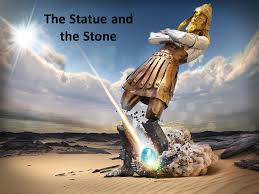 This is what sets the stage for the final act of history. By this the world becomes ripe for the invasion of God. That last act is given to us now in Verses 44-45:
This is what sets the stage for the final act of history. By this the world becomes ripe for the invasion of God. That last act is given to us now in Verses 44-45:
"And in the days of those kings the God of heaven will set up a kingdom which shall never be destroyed, nor shall its sovereignty be left to another people. It shall break in pieces all these kingdoms and bring them to an end, and it shall stand for ever; just as you saw that a stone was cut from a mountain by no human hand, and that it broke in pieces the iron, the bronze, the clay, the silver, and the gold. A great God has made known to the king what shall be hereafter. The dream is certain, and its interpretation sure." (Daniel 2:44-45)
Our attention is immediately drawn to this opening phrase, "And in the days of those kings." What kings? There have not been any kings mentioned in this passage at all. Kingdoms, yes; kings, no. "In the days of those kings" -- what a cryptic reference this is. But as you compare this passage with other passages in the seventh chapter of Daniel. and also with the book of Revelation, it becomes clear that the final form of the Western confederacy of nations will be the emergence of a confederation of ten nations, here symbolized by the ten toes of this image. The only possible antecedent for the reference to "those kings" is the ten toes of the image. In the days when the ten-kingdomed empire emerges as the final form of the fourth kingdom (essentially Roman in its emphasis and characteristic), then God, in those days, shall set up a kingdom which shall not be destroyed. (The Last Act, by Ray Stedman)
When we go back to the birth of Christ and His genealogy, it is full of surprises. It is protected with a security system written into the text. There is an authentication code which acts like an automatic security monitor, and it watches every little letter of the text. The system never wears out, and it has been running continually for several thousand years. This is the fingerprint signature of the Author and it is designed to avoid compromise.
Sevens in the Bible
Sevens occur in over 600 passages in the Bible. Many of them are implicit, some are very overt, and some are very structural, hidden under the text.
That underlying heptadic (sevenfold) structure of the text can serve as a fingerprint of the Author.
To illustrate this, try to create a fictitious genealogy. This can be the genealogy of anyone, but there are a few rules:
Now, if you have only one rule, you have one chance in seven of getting it right. If you have two rules, and you just do it by random chance, you will have one chance in 49 of getting it right. But now we have more rules.
The number of words that:
And just a few more rules for your genealogy:
Okay, that’s probably enough rules. This is a description of the genealogy of Jesus Christ as found in the first eleven verses of Matthew. And all of this has to be in the Greek language which is probably the most precise, rigid language ever written, and each letter has its own Greek alphanumeric number.1
Greek Alphanumerics
| α | 1 | κ | 10 | ρ | 100 |
| β | 2 | κ | 20 | σ ς | 200 |
| γ | 3 | λ | 30 | τ | 300 |
| δ | 4 | μ | 40 | υ | 400 |
| ε | 5 | ν | 50 | φ | 500 |
| ϛ* | 6 | ξ | 60 | χ | 600 |
| ζ | 7 | ο | 70 | ψ | 700 |
| η | 8 | π | 80 | ω | 800 |
| θ | 9 | 90 | §* | 900 |
*Vau(6), Koppa(90), and samsi(900), later became extinct.
The chart below shows that with just nine rules for this genealogy, there is only one chance in over 40 million of creating this genealogy by random chance.Chances of Multiples of 7 |
|
For 2 72=7x7 |
49 |
For 3 73=7x7x7 |
343 |
For 4 74=7x7x7x7 |
2,401 |
For 5 75 |
16,807 |
For 6 76 |
117,649 |
For 7 77 |
823,543 |
For 8 78 |
5,794,801 |
For 9 79 |
40,353,607 |
Now, as amazing as that is, there is even more. In the rest of Matthew 1 there are 161 words, and they also maintain a very elaborate heptadic structure underneath the text.
So how long would it take for someone to construct such a genealogy? Assume they will work eight hours a day, 40 hours a week, 50 weeks a year, and have two weeks off for Christmas. That will be 2,000 hours, man-hours, per week, or 120,000 minutes per year.
The number of attempts needed, if this is randomized, would be 7 to the 9th power, or 79. That would be over 40 million attempts.
Say it would take an average of ten minutes to try one draft; that would be 403 million minutes. This little project will take about 3,000 years of work. This is laid out just to demonstrate that anyone who would say the probability of this happening by a statistical randomness is incredibly naive. Some scribe didn’t sit down and go through these calculations to make it come out that way.
These discoveries were actually made by Dr. Ivan Panin, and he is famous for this very thing—the hepatic structures underlying the Biblical text. Dr. Panin was born in Russia in 1855, immigrated to the United States at an early age, and graduated from Harvard with a PhD in mathematics. In 1882, he became a Christian. When he discovered the heptadic structures of the text, he spent the remainder of his life (fifty years) generating 43,000 pages of discoveries. He went to be with the Lord in 1943.
The Two Genealogies
The Bible provides us with two lengthy genealogies of Christ. Matthew, as a Levite, focuses on the Messiahship of Jesus in that he traces the legal line from Abraham (thought to be the first Jew) through David, then Solomon and the royal line, to Joseph, the legal father of Jesus (Matthew 1:1-17) and the husband of Mary. Luke, as a physician, focuses on the humanity of Jesus. He traces the blood line from Adam (the Son of God versus us, the sons of Adam) and once Luke gets to Abraham, the genealogy is identical to Matthew’s up to the House of David. Then Luke goes from David, through Nathan (a different son of David) to Mary, the mother of Jesus (Luke 3:23-38).
Let’s take a look at the last ten people mentioned at the end of Luke 3:
which was the son of Noe, which was the son of Lamech, Which was the son of Mathusala, which was the son of Enoch, which was the son of Jared, which was the son of Maleleel, which was the son of Cainan, Which was the son of Enos, which was the son of Seth, which was the son of Adam, which was the son of God.
Luke 3:36d-38
If we translate those names from their Hebrew roots they will spell out a sentence. In other words, there is a hidden message in this genealogy.

When all of that is put together, we have a summary of the Christian Gospel hidden away in the genealogy of the Torah: Man is appointed mortal sorrow but the blessed God shall come down teaching that His death shall bring the despairing comfort or rest.
Look more closely and see Who’s death is being predicted. It is God’s death.
All of this tells us that there is more going on here than just a simple list of family names. The entire thing is being designed with a profound end in view.
After Luke, we switch to Matthew.
The Birth of Jesus fulfilled the following Specifications:

He had the most distinguished Family Tree in history:
— Encrypted in the Torah in Genesis 38
— Prophesied in Judges and Ruth 4
— Evades the blood curse on Jeconiah in Jeremiah 22:20
— Virgin Birth in Genesis 3:15; Isaiah 7:14 Psalm 69; Psalm 110
The Book of Ruth
Another amazing story about the genealogy of Jesus is in the Book of Ruth. When we carefully study Ruth and Genesis we discover that Boaz, Obed, Jesse, and David have all been prophesied in both books.
Why was Jesus born in Bethlehem? The Book of Ruth is especially important to us at Christmas because it answers that question. Bethlehem was established as the “House of David” because of the events in the Book of Ruth. That designation had implications for Joseph and Mary when Caesar Augustus ordered a special tax to be levied.
"And all went to be taxed, every one into his own city. And Joseph also went up from Galilee, out of the city of Nazareth, into Judaea, unto the city of David, which is called Bethlehem; (because he was of the house and lineage of David:) To be taxed with Mary his espoused wife, being great with child." (Luke 2:3-5)
Bethlehem is where the shepherds were in their fields on that momentous night:
And there were in the same country shepherds abiding in the field, keeping watch over their flock by night. And, lo, the angel of the Lord came upon them, and the glory of the Lord shone round about them: and they were sore afraid. (Luke 2:8-9)
Many believe (including the author) that those fields were the fields of Boaz and Ruth, so even their fields played a part in the birth of Christ.
Ruth is the ultimate love story in many ways. It is studied in some college classes just as an elegant piece of literature quite apart from its supernatural origin. At the literary level it is much respected. But at the prophetic and personal levels it can have a profound impact on every one of us. It is one of the most significant books of the Old Testament for the church.
The Book of Ruth profiles the role of the kinsman-redeemer and is often regarded as an essential prerequisite to understanding Revelation 5. It can often be difficult to comprehend that you and I are the beneficiaries of a love story that was written in blood on a wooden cross erected in Judea some 2,000 years ago. However, knowing the story of Ruth and the ramifications of that book, brings the sacrifice of Jesus, our Kinsman-Redeemer, into sharper focus.
In Ruth, we have this interesting case where a Gentile daughter-in-law, after the death of her husband, insists upon clinging to her Jewish mother-in-law. Numerous events occur prior to a famous scene on the threshing floor where Ruth makes the request of Boaz, a rich land owner, to take her as his bride.
The major scene occurs in chapter four when Boaz confronts the relative who’s in the way of the marriage and the return of the land. This “nearer” kinsman was willing to redeem the property, but not willing to take Ruth as a bride. So he yields his shoe2 to relinquish his right of redemption. Then Boaz steps up, purchases the land for Naomi, and purchases Ruth as a bride.
As they celebrate this romantic end of this love story, there is a comment made at the wedding, “May your house be like Pharez.” At first glance, this sounds like a lovely toast at a wedding. However, the Bible has a difference perspective on it, which we will examine more closely later. The Book of Ruth provides us with a perfect outline, chapter by chapter:
The Kinsman-Redeemer
To the Greek (or Western) mind, prophecy is a prediction and a fulfillment. To the Jewish mind, prophecy is a pattern, or type. In the situation with Ruth, Boaz is acting as a kinsman-redeemer, and that role required that four conditions be met:
— He had to be a kinsman.
— He had to be able to perform the redemption.
— He had to be willing to do it.
— He had to assume all the obligations.
That is exactly what Boaz ends up doing for Ruth and Naomi, and that is exactly what Christ does for us.
— He had to be a kinsman of Adam, a human being.
— He had to be sinless in order to be able to perform the redemption.
— He had to be willing to do it. Gethsemane shows this was true.
— He also had to assume all the obligations. He has made us the people of God.
So, Boaz is the lord of the harvest and the kinsman-redeemer in the story, and he also typologically represents our Kinsman-Redeemer, Jesus Christ. Naomi is the symbol of Israel who has lost her land, but through Boaz’s act of redemption she is returned to her land. And Ruth is his Gentile bride. All of this makes the parallelism very real.
Another interesting fact about this story is that the reading of the Book of Ruth is always associated with the Feast of Shavuot, the Feast of Weeks or the Feast of Pentecost, the very feast that celebrates the birth of the church.
As we continue to examine the Book of Ruth, we notice several instructive points:
— Ruth, a Gentile, does not replace Naomi, an Israelite.
— Ruth learns of Boaz’s ways through Naomi.
— Naomi meets Boaz through Ruth.
— Boaz loved Ruth, but he had to await her move
— Boaz, not Ruth, confronts the nearer kinsman (Deuteronomy 25:5-10)3
— The Book of Ruth is always read at the Feast of Shavuot
The Strange Prophecy
There is also a very strange prophecy in the Book of Ruth:
"And let thy house be like the house of Pharez, whom Tamar bare unto Judah, of the seed which the LORD shall give thee of this young woman." (Ruth 4:12)
This sordid tale goes back to Genesis 38, where Tamar is forced to contrive an illegitimate son from Judah, her father-in-law, in order to continue the messianic line. She gave birth to twins, and the one connected to the Book of Ruth is Pharez (Perez), who was considered illegitimate. It would be a disdainful thing for someone at the wedding to say, “May your house be like Pharez” because most everyone there would know about Perez as well as the Law:
"A bastard shall not enter into the congregation of the LORD; even to his tenth generation shall he not enter into the congregation of the LORD." (Deuteronomy 23:2)
Boaz was in the seventh generation after Perez. Ruth 4:18 has the genealogy after Perez—Hezron, Ram, Amninadab, Nashon, Salmon, Boaz, Obed, Jesse, and David. David is the tenth generation. God had planned for David to be king from the beginning. But the line had to be cleared for ten generations before David could come forth. In fact, the “tenth man” in the Old Testament is always very relevant.
| Adam | Shem | Isaac | Perez |
| Seth | Arphaxad | Jacob | Hezron |
| Enosh | Salah | Judah | Ram |
| Kenan | Eber | Perez | Amminadab |
| Mahalalel | Peleg | Hezron | Nahson |
| Jared | Rue | Ram | Salmon |
| Enoch | Serug | Amminadab | Boaz |
| Methuselah | Nahor | Nashon | Obed |
| Lamech | Terah | Salmon | Jesse |
| Noah | Abraham | Boaz | David |
This was prophesied long, long before even the days of Boaz and Ruth. In fact, look at another section of Genesis 38, the very heart of the Torah. In the Hebrew text, at 49-letter intervals, the name “Boaz” appears.
Using this pattern of a 49-letter interval for each letter, we also find the name “Ruth.”
Following her name, at a 49-letter interval, is the name “Obed,” and then “Yishay” (Jesse), and then again, continuing, there is the name of “David.”
So here we have Boaz, Ruth, Obed, Jesse, and David in 49-letter intervals, all in chronological order, hidden in the text. Statistically, the likelihood of this happening by accident or chance is absurd. This is by design.

What is even more bizarre about this design is that it is in the Book, it’s in the Torah, the five books of Moses, long before Joshua, before Judges, even before Samuel the prophet, who anointed David (1 Samuel 16:13). David is a very key figure in all of these things.
Let’s take a more extensive look at the House of David. Matthew, being a Jew, began the genealogy of Jesus with Abraham. Then he goes through to David, Solomon, and on to Josiah and Jehoiakim. To really understand this, we need to back up and look at some history.
After Solomon died, the nation split into two houses: northern (Israel) and southern (Judea). The northern house went through nine different dynasties, each going from bad to worse and finally obliterated from history under the Assyrian invasion. The southern house had only one dynasty, the Davidic dynasty. Due to God’s commitment and covenant to David, there is only the one dynasty for the Jews, and it is perpetual.
Of course, some of the specific kings in that dynasty were chastised when they did not perform well, such as Ahaziah, Joash, and Amaziah--who all died violent deaths. God was thus dealing with idolatry literally “to the third and fourth generations” (Exodus 20:4, 5). Their names therefore were “blotted out” according to the Law (Deuteronomy 29:20). However, the Davidic dynasty stayed intact. When the royal line got to Jehoiachin (also called Jeconiah or Coniah), things had gotten so bad that God pronounced a blood curse on him.
The Blood Curse
Thus saith the LORD, Write ye this man childless, a man that shall not prosper in his days: for no man of his seed shall prosper, sitting upon the throne of David, and ruling any more in Judah. (Jeremiah 22:30)
This is just amazing! When God pronounced this blood curse, there must have been a celebration in the councils of Satan because, from Satan’s point of view, God has put himself in a contradiction. God indicated in Genesis 49 that the Messiah was going to come from the tribe of Judah and specifically from the line of David. Then God pronounced a blood curse on that royal line that “no man of his seed shall prosper sitting upon the throne of David and ruling any more in Judah.” God’s adversaries must have been overjoyed at this. Just imagine, at this point, God turning to the angels and saying, “Watch this one.”
Pay close attention, now, because this can get complicated. The Matthew account goes down through Jehoiachin and finally gets to Joseph, who is the “legal” father of Jesus Christ. He is in the legal line of the house of David.
And Jacob begat Joseph the husband of Mary, of whom was born Jesus, who is called Christ. (Matthew 1:16)
Joseph was “the husband of Mary,” not the father of Jesus Christ, except in a legal sense.
To completely understand what is going to happen here, one needs to understand an exception in the Torah that was made for the daughters of Zelophehad.
How incredible that every detail—even in the regulations of the Torah—are there by deliberate design and always point to Christ. There is a peculiar exception recorded in the Torah, the result of a petition by the daughters of Zelophehad which provided for inheritance through the daughter, if no sons were available and she married within her tribe.4 It became traditional, in such cases, that the father would legally adopt his son-in-law.5
Just to be clear, this exception provided for the husband to become the “son” of the father–of–the–bride. And this exception anticipates the lineage of Jesus Christ. It also gives credence to the concept that every detail in the Bible is not only there by design, but also impacts directly the Messiah and the Messiahship. Joseph was the son-in-law of Heli, the father of Mary. In Luke 3:23, the word that is used in the Greek is the proper usage of the verb, nomizo, which means “reckoned as by law.” The way nomizo should be translated is, “Joseph was the son-in-law of Heli” (by legal adoption).
The Virgin Birth
This miraculous event was hinted at in the Garden of Eden when God speaks of the Redeemer as “the seed of the woman…” (Genesis 3:15). That becomes a title of Jesus Christ. It was prophesied by Isaiah:
Therefore the Lord himself shall give you a sign; Behold, a virgin shall conceive, and bear a son, and shall call his name Immanuel. (Isaiah 7:14)
Some skeptics quibble about the Hebrew word for “virgin” in verse 14. It is ha alma meaning “the virgin”; this is not just any virgin, but the virgin. Some say that it can mean just a young maid. If that were the case, how could that be “a sign”? Almost any young maid could conceive and bear a son. The context is clear that it means “a virgin.” In fact, in the Septuagint, three centuries before Christ was born, the Jewish translators used the Greek term parthenos, which means clearly, specifically, and scientifically “a virgin.” Those Hebrew experts, greater scholars than the modern skeptics, translated the Hebrew word ha alma, virgin, so that it is absolutely unambiguous.
The Isaiah prophecy is presented in Matthew as being fulfilled:
Now the birth of Jesus Christ was on this wise: When as his mother Mary was espoused to Joseph, before they came together, she was found with child of the Holy Ghost. Then Joseph her husband, being a just man, and not willing to make her a publick example, was minded to put her away privily. (Matthew 1:18-19)
Joseph was concerned about Mary being stoned, as that was the punishment for adultery in those days.
But while he thought on these things, behold, the angel of the Lord appeared unto him in a dream, saying, Joseph, thou son of David, fear not to take unto thee Mary thy wife: for that which is conceived in her is of the Holy Ghost. And she shall bring forth a son, and thou shalt call his name JESUS: for he shall save his people from their sins. Now all this was done, that it might be fulfilled which was spoken of the Lord by the prophet, saying, Behold, a virgin shall be with child, and shall bring forth a son, and they shall call his name Emmanuel, which being interpreted is, God with us. (Matthew 1:20-23)
The blood curse from Jeremiah 22 is closely tied to this issue. In fact, when we examine closely the blood curse on the royal line, the virgin birth becomes a requirement. Notice that the genealogy given in Luke comes down through Heli, who is the father-in-law of Joseph. Jesus Christ, the Messiah, is of the House and lineage of David: of the House of David legally, and of the lineage by blood. That lineage is not the bloodline through Solomon, but through Nathan, the second surviving son of David and Bathsheba. In other words, Luke takes a left turn and goes to another son—not Solomon, but Nathan.6
1 The Greek and Hebrew languages are distinctive in that each letter of the alphabet has a numerical value.
In Greek, a couple have been abandoned through the years, but it has that same characteristic. That means that every word has a numerical value. Also, every verb in the Greek language has to meet five independent conditions to fit in properly.
2 See Duteronomy 25:9-10 to understand Ruth 4:7-8. This business with the shoe was an old custom.
3 Normal procedure here, where the call to a Levirate marriage was taking place, would be for the would-be bride to confront the near kinsman. Boaz takes that responsibility and confronts the man himself
(Ruth 4:1-10).
5 Ezra 2:61; Nehemiah 7:63; Numbers 32:41, cf. 1 Chronicles 2:21-22, 34-35; Numbers 27:3-8
6 Salathiel, the (“adopted”) son of Jeconiah (Mt 1:12; 1 Ch 3:17) is also called the son of Neri (Lu 3:27). If these are the same person, a probable explanation is that the son of Neri, the descendant of Nathan, was deemed heir to the throne of David on the death of Jeconiah (Jeremiah 22:30) due to the blood curse. From E. W. Bullinger’s Companion Bible, App 99.
This article was originally published in the
December 2020 Personal Update News Journal.
A video on the history of Christmas in the West was recently posted by Creation.com. They address issues such as: Is Christmas based on pagan traditions?
Should Christians celebrate Christmas? Some people suggest that most Christmas holiday traditions came from the pagan world. Is Christmas based on pagan traditions?
Is there anything about Christmas that’s genuinely Christian?
The Christmas Star is the subject of two provocative YouTube videos by Barry Setterfield, Part 1, Part 2.

But this is supposed to be about Christmas!
My pastor Andy Burnham wrote recently, “And she brought forth her firstborn son, and wrapped him in swaddling clothes, and laid him in a manger; because there was no room for them in the inn.” (Luke 2:7)
When Jesus was born—when God entered the world in human form—he was born in obscurity. He was born in a small town at the eastern end of the Roman Empire, far from the center of worldly power. Moreover, even in the small town where he was born—the small town of Bethlehem--there was no room for his parents at the inn. As a result, Jesus was born outside the inn and his first crib was a manger—a feeding trough for animals.
The question of course is: why did God enter the world in obscurity? Why did he enter the world far from the center of worldly power, born outside of an inn with a feeding trough for a crib? Why not enter the world in Rome or Jerusalem? Why not enter the world in a palace with the angels proclaiming the good news for all to hear, not just for a few shepherds on a remote hillside?
As many have observed, the answer—the answer to the obscurity of Jesus’ birth—has to do with the human heart. Namely, God came into the world in a way that pictures the human heart. He came into the world in a way that pictures humanity’s attitude toward him. Sadly, the truth is, most hearts have no room for Jesus. Most hearts want God to remain distant and obscure, far from the center of their lives.
Ultimately, Jesus died in obscurity as well. He died a criminal’s death, nailed to a cross on a rocky hill outside Jerusalem. He was born outside the city, and he died outside the city. The Creator of the universe was an outsider to his own creation. He died rejected and scorned. As the Lord himself declares, speaking through the prophetic words of Psalm 22—the psalm recounting his crucifixion and the way he was treated—"But I am a worm and not a man, scorned by mankind and despised by the people. All who see me mock me;” (Psalm 22:6-7a).
Thankfully, although most people have no room in their hearts for Jesus, this is not true of everyone. Although most people want God to remain distant and obscure, far from the center of their lives, not everyone does. To those—to those who have room in their hearts for Jesus, to those who wish to receive Jesus into the center of their lives—the scriptures declare: “But to all who did receive him, who believed in his name, he gave the right to become children of God.” (John 1:12).
My prayer is that everyone reading this devotional will be among those who have room in their hearts for Jesus. My prayer is that everyone reading this devotional will believe in his name and in everything his name stands for. May you believe in his name, become one of his precious children, and look forward to spending eternity with him and with all those who have placed their faith in him. (December 14, 2020)

O Come, O Come, Emanuel
Handel's Messiah
Silent Night
Angels we Have Heard on High
O Come All Ye Faithful
Pachelbel Canon in D
O Holy Night
Glory in Excelsis Deo (Vivaldi)
Christmas Oratorio (Johann Sebastian Bach)
Carols from Kings College Cambridge
Traditional Christmas Carols
Anthem Lights
Come, Thou Almighty King
Merv and Marla Watson
Carmina Burana
Pachelbel: Canon in D
My Musical Taste
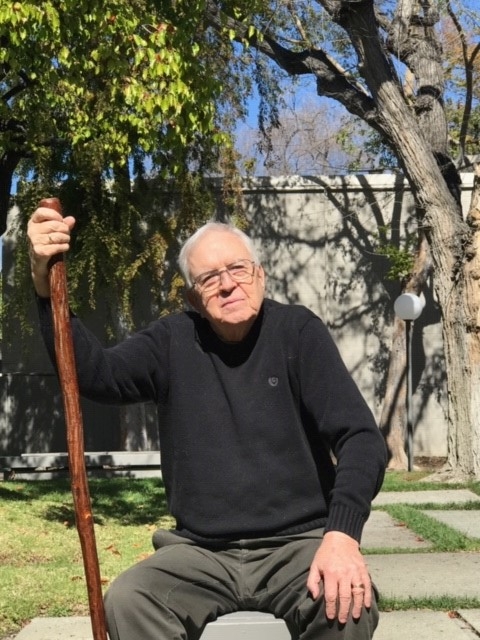
Email Lambert Dolphin
Lambert Dolphin's Place
December 16, 2020